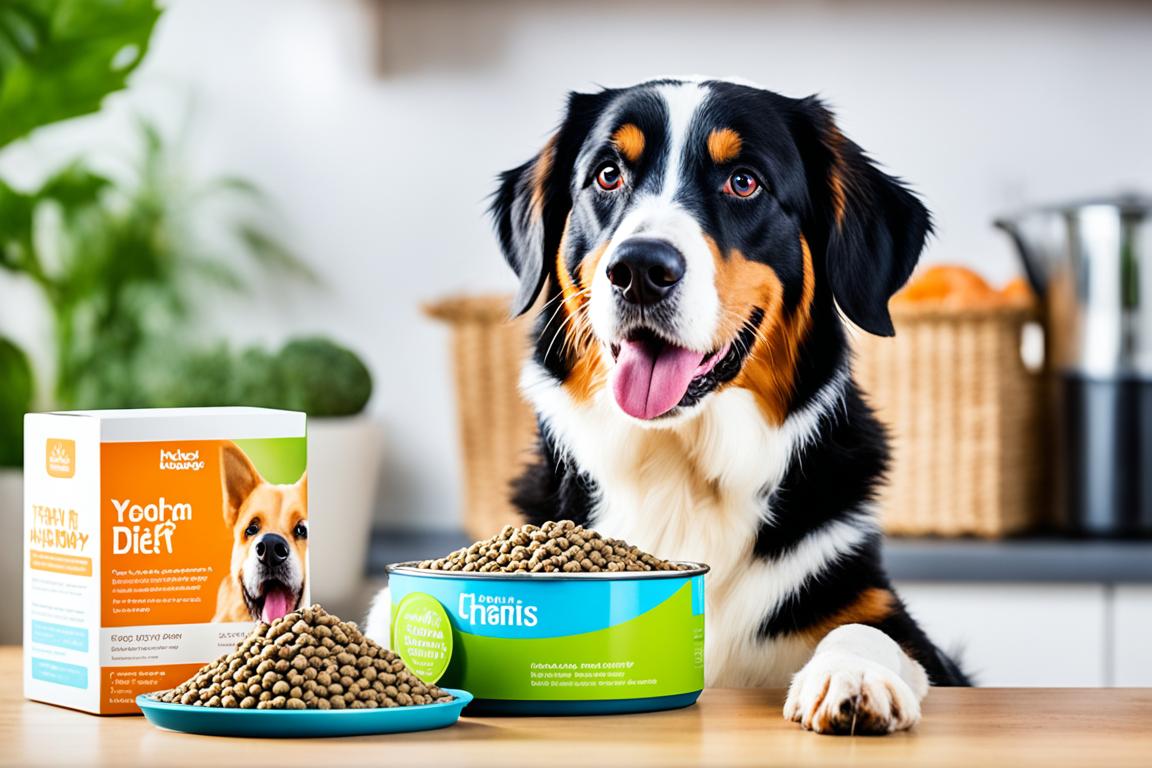
As a dog owner, my journey through the world of dog food allergies has taught me the critical importance of hypoallergenic dog food and the complications that arise in navigating dietary needs and allergies for dogs. These issues are more than just an inconvenience; they can profoundly impact our canine friends’ quality of life. Understanding how to pinpoint, manage, and accommodate these dietary challenges isn’t just caretaking; it’s a labor of love dedicated to the health and happiness of our beloved pups.
In my experience, every dog is a unique individual with their own set of nutritional requirements and potential sensitivities. The signs of allergies can be subtle but understanding them is the first step towards providing relief and comfort. If you’re navigating this terrain for the first time or looking to refine your approach, stay tuned as I share the insights and strategies I’ve gathered on this topic.
Key Takeaways: Allergies for Dogs and Dietary Needs
- Identifying the signs and managing dog food allergies is crucial for your pet’s well-being.
- Choosing the right hypoallergenic dog food can significantly improve a dog’s quality of life.
- Each dog’s dietary needs are unique and require personalized attention.
- Being vigilant and proactive is key when dealing with dog allergies.
- A loving pet owner’s role entails continuous learning about their dog’s health needs.
- Supplement with Allergy Relief Immunity
- Understanding Allergies for Dogs and Dietary Needs
- Identifying Allergies: The Elimination Diet
- Best Dog Food for Allergies: What to Look For
- Canine Food Sensitivities: Tailoring Your Dog’s Diet
- Hypoallergenic Dog Food: Is It the Best Choice?
- Homemade Meals: Controlling Your Dog’s Diet
- Reading Dog Food Labels: Allergy-Friendly Ingredients
- Managing Dog Dietary Restrictions in Multi-Pet Households
- Dog Food Intolerance Remedies and Supplements
- Customized Dog Diet Plans: When to Consult a Veterinarian
- Allergy-Friendly Dog Food Options on the Market
- Conclusion: Allergies for Dogs and Dietary Needs
Understanding Allergies for Dogs and Dietary Needs
As a pet owner, my journey to finding the best dog food for allergies was anything but straightforward. Discovering that my dog suffered from canine food sensitivities meant arming myself with knowledge to identify and manage the condition effectively. It became clear that before delving into customized dog diet plans, I had to grasp the differences between food allergies and food intolerances in dogs.
The Difference Between Allergies and Intolerances
Food allergies occur when my dog’s immune system mistakenly identifies a specific food as dangerous, triggering a defensive response. This is different from food intolerances, which are digestive problems that occur when a certain ingredient does not sit well with my canine companion. Unlike allergies, intolerances don’t involve the immune system but can still cause discomfort and adverse health effects.
Common Allergens in Dog Food
Some frequent allergens that plague dogs include protein-rich ingredients like beef, dairy, and wheat. Moreover, other potential triggers such as chicken, soy, and certain preservatives can also lead to reactions. The quest for hypoallergenic diets formulates an essential part of managing my dog’s dietary restrictions.
Signs Your Dog May Have a Food Allergy
Identifying the signs of food allergies in my dog was critical for a timely intervention. Symptoms can range from chronic ear inflammation, gastrointestinal issues, to skin irritations like itching and hives. It is these symptoms that often drive pet enthusiasts, like myself, to seek out the best dog food for allergies, providing our beloved canines with much-needed relief.
Identifying Allergies: The Elimination Diet
As a pet owner, it’s distressing to see our furry friends suffer from allergies. The good news is that allergy-friendly dog food options and dog food intolerance remedies are accessible and effective. An elimination diet is a diagnostic tool that plays a crucial role in managing dog dietary restrictions. So, let’s begin the journey to uncover what’s troubling your canine’s tummy.
Starting the Elimination Diet: The Basics
An elimination diet is the gold standard for identifying food allergies in dogs. It involves removing all but the most innocuous ingredients from your dog’s meals. We’re talking about feeding them a diet that consists of proteins and carbohydrates they’ve never eaten before. It’s akin to pressing the reset button on your dog’s immune system’s reaction to food.
Maintaining a Food Diary for Your Canine
During this restrictive phase, I highly recommend keeping a meticulous food diary for your dog. Record everything: each meal, any treats, reactions, or the lack thereof. This log is your best friend in tracking your furry pal’s progress and will become invaluable when identifying potential allergens during the reintroduction phase.
Reintroduction Phase: Isolating the Culprit
After a period of feeding your dog this simplified diet, you’ll slowly reintroduce other foods one at a time, each over a week or more. The aim? To observe and document any adverse reactions which may signify an allergy. This phase requires patience and attention to detail, but it can shine a light on which ingredients agree with your dog, and which do not.
| Week | Food Ingredient | Canine Reaction | Notes |
|---|---|---|---|
| 1 | Salmon | No Reaction | Salmon introduced as novel protein, tolerated well. |
| 2 | Brown Rice | No Reaction | Chose brown rice for its digestibility, no issues observed. |
| 3 | Chicken | Itching and redness | Signs of allergic reaction noted, chicken to be avoided. |
| 4 | Sweet Potato | No Reaction | Well received, promising ingredient for a hypoallergenic diet. |
Undertaking an elimination diet for your dog may seem daunting at first, but understanding the process and knowing how to proceed makes all the difference. Stick with it, and you may just provide your dog with the comfort and relief they deserve. With each reintroduced item, you’ll become a more informed advocate for your furry companion’s health, navigating the world of allergy-friendly dog food options, formulating dog food intolerance remedies, and managing dog dietary restrictions with newfound clarity.
Best Dog Food for Allergies: What to Look For
When it comes to finding the superb hypoallergenic dog food, the vast array of choices can be overwhelming. Knowing what to look for in allergy-friendly dog food options is imperative for the well-being of our canine friends who require special dietary consideration. I’ll guide you through the essential components to consider when shopping for dog food that’s formulated to combat allergies.
Focusing on the ingredient list is paramount as it reveals the presence of potential allergens. Look for dog foods that feature a single protein source, especially novel proteins such as venison or duck, which are less likely to have caused an allergic reaction in the past. Keep an eye out for foods that explicitly state they are free from the most common allergens like beef, dairy, and wheat.
Another aspect to consider is the brand’s reputation and transparency. Opt for products from brands that have a strong track-record for quality and are endorsed by veterinarians. These brands typically have rigorous testing protocols to ensure their products are genuinely hypoallergenic, thus reducing the risk of allergic reactions.
- Simplify: Choose dog foods with a short list of ingredients.
- Natural: Select foods with natural components over synthetic additives.
- Grain-Free: Consider grain-free diets to eliminate common grain allergens.
- Omega Fatty Acids: Foods rich in omega-3 and omega-6 fatty acids support skin health.
- Supplement with Pet Honesty Allergy Relief Immunity
Moreover, be wary of misleading labels. Terms like ‘natural’ or ‘organic’ do not necessarily mean the food is hypoallergenic. It’s essential to decipher the terminology and understand whether these claims are substantiated.
For clarity, here’s a table that outlines criteria to look for in hypoallergenic dog food:
| Criteria | Details | Benefit |
|---|---|---|
| Single Protein Source | A single, novel animal protein (e.g. rabbit or salmon). | Reduces likelihood of allergic responses. |
| Limited Ingredients | Fewer components, especially novel ones, to lower allergen exposure. | Allows easier identification of problem ingredients. |
| Grain-Free Options | No wheat, corn, or soy to eliminate common irritants. | Ideal for dogs with grain sensitivities. |
| Supplemented With Fatty Acids | Rich in omega-3 and omega-6 for skin and coat health. | Helps mitigate allergic skin reactions. |
Finding the right diet for a dog with allergies may take time, but armed with the right knowledge, I am confident that we can make informed choices to ensure their optimal health and happiness.
Canine Food Sensitivities: Tailoring Your Dog’s Diet
As a dedicated pet parent, I understand the complexities involved in managing dog dietary restrictions. It’s not simply about avoiding certain ingredients; it’s about a comprehensive approach to crafting customized dog diet plans that cater to our canine companions’ individual health requirements. Through a combination of research and vet consultations, I’ve learned how to make nutritional adjustments that ensure my dog thrives despite sensitivities.
Nutrient Balance is Key
- Ensure the right balance of protein, fats, and carbohydrates
- Incorporate essential vitamins and minerals
- Adjust portions according to energy needs and weight management
Choosing the Right Foods
- Select high-quality ingredients that agree with your dog’s system
- Opt for natural, whole-food options when available
- Avoid artificial preservatives and colorants that may exacerbate allergies
| Ingredients to Consider | Ingredients to Avoid | Notes |
|---|---|---|
| Novel proteins (e.g., venison, duck) | Common allergens (e.g., beef, chicken) | Novel proteins are less likely to cause reactions |
| Complex carbohydrates (e.g., sweet potatoes) | Simple sugars and grains | Complex carbs are digested slowly, minimizing risk of intolerance |
| Omega-3 fatty acids (e.g., fish oil) | Common vegetable oils | Omega-3s support skin health and reduce inflammation |
By adhering to these guidelines and embracing customized dog diet plans, I’ve found joy in managing dog dietary restrictions effectively. It’s not just about a diet; it’s about fostering a happy, healthy life for our beloved dogs.
Hypoallergenic Dog Food: Is It the Best Choice?
When it comes to managing our furry friends’ allergies, the quest for the best dog food for allergies often leads us to explore the realm of hypoallergenic dog food. These specialized diets are crafted to minimize the risk of allergic reactions and can be a sanctuary for pets plagued by persistent symptoms. But, are they the ultimate solution for every dog with dietary sensitivities? Let’s delve into what hypoallergenic dog food entails and examine its advantages and potential limitations.
What Makes a Dog Food Hypoallergenic?
A dog food is dubbed hypoallergenic when it’s delicately formulated to reduce the chance of provoking an allergic response. Typically, hypoallergenic dog foods avoid common allergens such as beef, dairy, and grains like wheat. Instead, they may feature novel proteins and carbohydrates that are foreign to a dog’s immune system, thereby reducing the likelihood of an allergic reaction. These novel ingredients might include venison, duck, or kangaroo for proteins and sweet potato or peas for carbohydrates.
Pros and Cons of Hypoallergenic Diets
In my journey to bring relief to canines with allergies, I’ve observed numerous benefits of hypoallergenic diets, as well as a few cons worth considering:
| Pros | Cons |
|---|---|
| Reduction in allergic symptoms | Can be more expensive than regular dog food |
| Inclusion of high-quality, novel ingredients | Limited flavor varieties may not appeal to all dogs |
| Often easier to digest and promote better skin health | May require veterinary consultation to ensure nutritional completeness |
| Can lead to improved overall wellness and energy levels | Transitioning to new food may initially cause digestive upset |
When contemplating whether hypoallergenic dog food is the right path, it’s essential to weigh these factors carefully. While there’s a possibility of greater cost and limited choices, the trade-off may be a dramatic improvement in your dog’s quality of life—making it a worthwhile investment for those battling severe allergies.
With the pros and cons laid out, you might be wondering if your beloved pet could benefit from a hypoallergenic diet. It often comes down to trial and error and observing how your dog responds to these changes. Consult with your veterinarian to discuss if a hypoallergenic dog food aligns with your dog’s specific health needs and if it’s indeed the best choice for alleviating their allergies.
Homemade Meals: Controlling Your Dog’s Diet
For those pet parents seeking a deeper involvement in their furry friend’s nutrition, shifting to homemade meals can be a transformative step. By preparing food for your dog at home, you’re able to cater to their taste preferences while also managing dog dietary restrictions with greater precision. Let’s delve into the vast benefits, nutritional guidelines, and allergy-friendly recipes that can help you craft customized dog diet plans fit for your companion’s unique needs.
Benefits of Home-Cooked Dog Food
The advantages of home-cooked meals for your dog are numerous. First and foremost, it’s about control: knowing exactly what goes into every dish provides peace of mind and ensures that your pet is getting wholesome, unprocessed ingredients. Home-cooking also allows you to adjust recipes in real-time, tailoring each meal to support allergies or health conditions. Moreover, it can strengthen the bond between you and your pet, as they begin to see you as not just their owner but also their provider of nourishing, delicious meals.
Nutritional Guidelines for Homemade Dog Meals
Before donning the chef’s hat, it’s critical to understand the nutritional needs of your dog. Every meal should be a balanced symphony of proteins, carbohydrates, fats, and essential vitamins and minerals. Consulting with a veterinarian nutritionist can help ensure your home-cooked diets meet all of the necessary dietary guidelines. They can also help you navigate around any dietary restrictions your dog may have, ensuring they get all the nutrients without triggering any allergic reactions.
Recipes for Dogs with Dietary Restrictions
Cooking for a dog with dietary restrictions doesn’t have to be a daunting task. There are countless recipes available that are designed to be both nutritious and delicious, while also avoiding common allergens. For instance, a simple dish of boiled lean meats, rice, and vegetables can suffice as a base for many dog diets. Allergy-friendly supplements can be added to these homemade meals to ensure your dog doesn’t miss out on any vital components in their diet.
Embarking on the journey of home-cooking for your dog may require some adjustment, but the benefits are clearly worth the effort. Tailoring meals to your dog’s specific dietary needs can help alleviate or prevent symptoms related to allergies and intolerances. For those committed to ensuring the best health outcomes for their canine companions, exploring customized dog diet plans through home-prepared meals is a meaningful way to express care and commitment.
Reading Dog Food Labels: Allergy-Friendly Ingredients
When I’m scouring the pet store aisles for the best dog food for allergies, the vast array of options can be overwhelming. But, becoming proficient in label interpretation is like unlocking a secret language that benefits my dog’s health. Understanding the jargon and the numbers isn’t just useful—it’s crucial for selecting allergy-friendly dog food options.
Deciphering Ingredients and Additives
Ingredient lists on dog food can be a minefield for those not familiar with the particulars. The key is to look for simple, recognizable ingredients that contribute to a balanced diet without unnecessary fillers or preservatives—those are often the safest bet for dogs with sensitive systems.
I pay special attention to the order in which ingredients are listed since they’re ranked by weight. The first few components are vital because they constitute the bulk of the meal. High-quality proteins should be at the top—think real meats, not by-products. And if there’s a mysterious “meat meal” with no specific source named, that’s a red flag for me.
Understanding Nutrition Facts and Allergen Statements
Despite popular belief, deciphering the guaranteed analysis on dog food labels isn’t just for nutritionists. It provides essential information about the percentages of protein, fat, fiber, and moisture. What I’m particularly interested in is the balance; a skewed ratio could spell disaster for a dog already battling allergies.
Allergen statements, often placed near the ingredients list, can be a lifesaver for maintaining my pooch’s well-being. They indicate potential allergens, which, if not heeded, could trigger an unwanted reaction. Labels that specify “grain-free” or “single protein source” can serve as guideposts toward safer feeding options.
| Label Feature | What to Look For | What to Avoid |
|---|---|---|
| Main Protein Source | Named meats (e.g., “chicken” or “salmon”) | Vague terms like “meat meal” |
| Carbohydrates | Whole grains, specific legumes, or sweet potatoes | Generic “grain products” or “cereals” |
| Fats/Oils | Named animal fats, fish oil, or plant oils | Generic “animal fat” or “vegetable oil” |
| Additives | Natural preservatives (e.g., mixed tocopherols) | Artificial colors, flavors, or preservatives (e.g., BHA, BHT) |
| Allergen Statements | Clear indicators of common allergens | Absence of allergen information or unclear labeling |
Thorough label analysis ensures that I am choosing the best dog food for allergies, minimizing unnecessary risks, and keeping my dog’s palate satisfied. With each label I decipher, I become more adept at ensuring a safe, healthy diet for my trusty sidekick.
Managing Dog Dietary Restrictions in Multi-Pet Households
For those of us with multiple furry friends at home, managing dog dietary restrictions can feel a bit like running a specialized café. I’ve discovered that vigilance and creativity play crucial roles in ensuring that each pet receives their appropriate meals, especially when dealing with allergy-friendly dog food options. It’s all about minimizing risk and maximizing health.
I’ll share some of the go-to strategies I’ve adopted to prevent cross-contamination between my pets’ foods. It’s been a journey full of trial and error, but these tips should serve as a good starting point:
- Assign separate feeding areas for each pet to avoid any accidental food swaps.
- Store different pets’ foods in clearly labeled containers.
- Always wash hands and feeding utensils thoroughly between handling different types of food.
- Create a feeding schedule and supervise meal times to ensure each pet sticks to its diet.
Another vital component I’ve had to pay attention to is the ingredients in the dog food itself. Here’s a simple comparison table that helped me keep track of suitable ingredients for each of my dogs:
| Dog’s Name | Allergy-Friendly Food | Avoid | Notes |
|---|---|---|---|
| Max | Lamb-based formula | Chicken, Beef | Prone to skin irritation |
| Bella | Grain-free, fish-based food | Wheat, Corn | Sensitive stomach |
| Charlie | Novel protein, limited ingredient diet | Dairy, Soy | Chronic ear infections |
And don’t forget, even the snacks need to fit within each pet’s dietary guidelines. More than once, I’ve caught myself reaching for a treat that wasn’t suitable for the particular dog at my feet.
Lastly, here’s the heartwarming sight that makes all the effort worthwhile – a picture of my dog, Max, with his special meal, looking as healthy and happy as can be!
In conclusion (but remember, our pets’ nutrition is never really concluded), managing multiple diets can be overwhelming, but with systematic organization and monitoring, it is certainly feasible. Each day presents a learning opportunity, and the joy of seeing our pets thrive is the ultimate reward.
Dog Food Intolerance Remedies and Supplements
Facing the challenge of dog food intolerances can be quite overwhelming. But fear not, as I’ve explored some effective remedies and supplements that could help bring relief to your furry friend. The goal is to reduce discomfort and restore digestive health through careful selection and administration of these aids.
Using Probiotics and Digestive Enzymes
It turns out that probiotics and digestive enzymes can work wonders for dogs with food intolerances. Probiotics introduce beneficial bacteria into the gut, balancing the microbiome to improve digestion and nutrient absorption. Digestive enzymes, on the other hand, assist in breaking down food components, easing the burden on a dog’s digestive system.
Natural Remedies vs. Medication: What’s Safer?
While some medications can address the symptoms of food intolerance, natural remedies tend to be gentler and safer over the long term. Natural options, like herbal extracts and dietary fibers, can support gut health without the side-effects that some medications may cause. Nonetheless, it’s imperative to discuss any new supplement or remedy with a veterinarian to ensure it’s appropriate for your dog’s unique health profile.
| Hypoallergenic Dog Food | Probiotics | Digestive Enzymes | Natural Remedies | Medications |
|---|---|---|---|---|
| Limited ingredient diets | Supports gut health | Helps breakdown food | Includes herbal supplements | Typically vet prescribed |
| Free from common allergens | May improve immunity | Reduces gastrointestinal stress | Gentle, holistic approach | Potential for side-effects |
| Formulated for sensitive dogs | Encourages a healthy microbiome | Can aid nutrient absorption | Often safer for prolonged use | Quick symptom management |
Ultimately, dealing with dog food intolerances requires a blend of patience, knowledge, and the right dietary changes. By incorporating hypoallergenic dog food and supportive supplements like probiotics, you may be able to significantly improve your dog’s quality of life.
Customized Dog Diet Plans: When to Consult a Veterinarian
As a dedicated pet parent, I’ve learned that understanding my dog’s unique dietary needs can require expert guidance. There’s an ocean of information out there about customized dog diet plans and hypoallergenic dog food, but nothing compares to professional advice from a veterinarian when your furry companion’s health is on the line. Let’s talk about when it’s essential to consult a vet for your dog’s diet.
First things first, if you’ve noticed any adverse reactions after your dog eats, like itchy skin, digestive troubles, or chronic ear infections, it may be time to explore hypoallergenic dog food. But, before you make any significant changes, a vet’s opinion could be the difference between a well-meaning mistake and a solution.
- Has your dog shown signs of food sensitivities or allergies?
- Are you considering switching to a full-blown hypoallergenic diet?
- Do you feel overwhelmed by the array of dietary options out there?
If you nodded along with any of these, you might want to book a vet appointment. Sometimes, what seems like a food allergy could be something else, like an environmental factor or another underlying health issue.
When you collaborate with your vet, they’ll likely suggest a detailed evaluation. This assessment could involve an elimination diet process, blood tests, or skin tests to identify the culprits causing discomfort. Once you have that clarity, a customized dog diet plan can be developed — one tailored just for your pooch.
“The goal is to create a balanced diet that meets your dog’s specific nutritional needs while eliminating the allergens causing harm.” – A common veterinary wisdom.
Remember, every dog is an individual. Like us, they can have wildly different reactions to foods, which means what works for one may not work for another, even if they’re the same breed. This understanding is what makes a customized approach so valuable.
For those especially tough cases where conventional hypoallergenic options don’t seem to cut it, or if your dog has multiple health issues, coming up with a diet plan alongside a vet becomes even more critical. It’s about finding that sweet spot where nutrition and taste meet your dog’s health requirements.
So, tailor-making your dog’s diet with a vet’s guidance can ensure that your pet not only survives but thrives. Taking the step to consult a professional can lead to a happier, healthier life for your canine friend — and peace of mind for you.
Remember, the best approach to your dog’s diet is one made with love and veterinary science in mind.
Allergy-Friendly Dog Food Options on the Market
When faced with canine allergies, dog owners like me often feel overwhelmed by the vast choices of dog foods claiming to meet every dietary need. Let’s explore the increasingly popular market of hypoallergenic and limited ingredient dog foods, designed with our sensitive pups in mind.
Reviewing Commercial Hypoallergenic Brands
The quest for the best dog food for allergies inevitably leads to commercial hypoallergenic brands. These companies have dedicated research into creating recipes that minimize the risk of allergic reactions. Brands like Royal Canin, Hill’s Science Diet, and Purina Pro Plan offer specialized formulas that cater to dogs with sensitivities. Each emphasizes the avoidance of common allergens and the inclusion of novel proteins and carbohydrates to keep our dogs healthy and symptom-free.
The Role of Limited Ingredient Diets
Another angle on allergy-friendly dog food options is the simplified approach offered by limited ingredient diets (LID). These diets are based on the premise that fewer ingredients mean fewer chances for allergic reactions. They focus on a single protein source and limited carbohydrate sources to satisfy a dog’s nutritional needs without the excessive filler that can aggravate allergies.
| Brand | Protein Source | Carbohydrate Source | Free From Common Allergens |
|---|---|---|---|
| Blue Buffalo Basics LID | Salmon, Turkey, or Lamb | Potato, Pea, or Pumpkin | Yes (No wheat, corn, soy, dairy, eggs) |
| Natural Balance LID | Duck, Fish, or Venison | Sweet Potato or Brown Rice | Yes (No artificial colors, flavors, or preservatives) |
| Canidae PURE | Buffalo, Chicken, or Wild Boar | Chickpeas or Sweet Potato | Yes (No wheat, corn, soy) |
By laying out these allergy-friendly dog food options, I hope to make your journey in finding the right meal for your allergy-afflicted furry friend a bit easier. Whether it’s a commercial hypoallergenic blend or a formula with only the essentials, relief from allergies is now more accessible than ever for our four-legged companions.
Conclusion: Allergies for Dogs and Dietary Needs
As we draw this discussion to a close, my journey alongside you, navigating dietary needs and allergies for dogs, has hopefully demystified much about customizing your beloved pet’s diet. The path to ensuring their health and contentment is paved with vigilance and care, recognizing that each dog is as unique as their dietary requirements. To thrive, they depend on our dedication to understanding and managing their nutritional needs with precision and patience.
Wrapping Up: Living with a Dog with Dietary Needs
The responsibility of living with a dog with dietary limitations can be daunting, yet it’s a challenge that comes with heartfelt rewards. Implementing customized dog diet plans may require an investment of time and effort, but witnessing the improvement in your dog’s health and happiness is a fulfilling achievement. With each meal tailored to your dog’s specific needs, you are providing them with more than just sustenance; you are giving them a quality of life they wouldn’t have otherwise.
Continuous Learning and Adaptation
Embrace the role of a lifelong learner when it comes to your furry companion’s care. The landscape of canine nutrition is ever-evolving, with new research and products continuously emerging. Staying informed enables you to adapt your dog’s diet and lifestyle as needed, ensuring that they remain at their healthiest. As you persevere in this endeavor, take pride in the knowledge that your efforts are creating a nurturing environment where your dog can thrive despite their dietary challenges.











